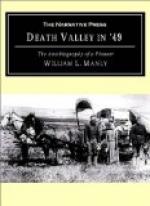We crossed the American River at Salmon Falls, and walked thence on to Sacramento City, which was the largest town we had seen on the coast. The houses were all small wooden ones, but business seemed to be brisk, and whiskey shops and gambling houses plenty. One game played with three cards, called three card Monte, was played openly on the streets, with goods boxes for tables. Every one who came along was urged to bet by the dealer who would lay out his cards face up so all could see them, then turn them over and shuffle them and say “I’ll bet six ounces that no one can put his finger on the queen.” I watched this a while and saw that the dealer won much oftener than he lost, and it seemed to be a simple and easy way to make a living when money was plenty.
We strolled around town looking at the sights, and the different business places, the most lively of which had plenty of music inside, lots of tables with plenty of money on them, and many questionable lady occupants. These business places were liberally patronized and every department flourishing, especially the bar. Oaths and vulgar language were the favorite style of speech, and very many of the people had all the whiskey down them that they could conveniently carry.
We got through the town safely and at the river we found a steamboat bound for San Francisco and the fare was two ounces. The runners were calling loudly for passengers, and we were told we could never make the trip any cheaper for they had received a telegram from below saying that no boat would come up again for two days. I said to him “I can’t see your telegram. Where is it?” At this he turned and left us. He had thought, no doubt, that miners were green enough to believe anything. In the course of an hour the smoke of a steamer was seen down the river, and this beat out the runners who now offered passage for half an ounce.
At this time there was no telegraph and the delay was a lucky one for us. We took passage and went to San Francisco that night, where we put up at a cheap tavern near where the Custom House now stands.
Here we learned that we would have to wait two days before a ship would sail for Panama, and during this time we surveyed the town from the hill-tops and walked all over the principal streets. It was really a small, poorly built, dirty looking place, with few wharves, poor, cheap hotels, and very rough inhabitants. There were lots of gambling houses full of tables holding money, and the rooms filled with pretty rough looking people, except the card dealers, most of whom wore white shirts, and a few sported plug hats. There was also a “right smart sprinkling” of ladies present who were well dressed and adorned with rich jewelry, and their position seemed to be that of paying teller at the gambling tables.
The buildings seemed to be rather cheap, although material was very expensive, as well as labor, mechanics of all sorts getting as much as ten or twelve dollars per day for work. Coin seemed to be scarce, and a great deal of the money needed on the gambling tables was represented by iron washers, each of which represented an ounce of gold.




